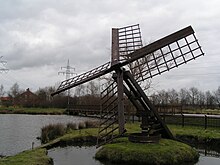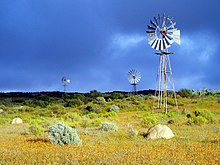Wind pump
A wind pump is a wind power converter that uses the wind to operate a pumping device . Historically, different designs were used. In addition to the European types of windmills with pumping devices, the American Westernmills, which have been mass- produced by the millions, are important representatives of wind pumps.
commitment
The main purpose was the promotion of drinking and drinking water as well as feed water for technical purposes, but there are also other areas of application, for example the drainage of swamp and moor areas or of newly reclaimed land near the coast . Wind pumps were also used to irrigate land. This also applies to the Chinese windmill (vertical axis of rotation, see folding wing rotor ), which was also used for salt production . In the meantime, the use of wind pumps has declined sharply in most industrialized countries, while in developing countries it is an inexpensive and environmentally friendly way of supplying water , especially far away from a central energy supply . The possibility of developing the remaining largely exhausted oil wells in regions with poor infrastructure is also being sought. In the meantime, several manufacturers have resumed the construction of Westernmills, so that the number of systems used may rise again.
There are currently over a million wind pumps in use worldwide. Economic data is available for modern wind pumps for Saudi Arabia . According to this, a 2.5 kW wind pump can deliver 30,000 m³ of water per year from a depth of 50 meters; In a good location, according to the study, the extraction costs were 1.28 US cents per cubic meter.
history



The history of wind pumps dates back at least to the 16th century, according to other sources even to the 14th century. Wind pumps were particularly important in the Netherlands , where they were used to drain the newly dammed polders as part of land reclamation or to drain lakes and swamps. Such extensive land reclamation measures as in the Netherlands would hardly have been possible with human and animal muscle strength alone. Initially, flutter mills were used for this, later coker windmills were used with a paddle wheel attached to the outside.
In the 16th century, mills with a rotating hood, the so-called Dutch windmills , were finally used for the first time . These had a higher output and thus took into account the increased demand for pump capacity. While Dutch windmills were mainly used as grain mills in the rest of Europe , their main purpose in the Netherlands was drainage. However, since the performance of a single system was often insufficient when draining land, the windmills were concentrated in groups, which can be seen as the forerunners of today's wind farms .
In contrast, steam pumps did not appear in the Netherlands until around 1850, and thus relatively late. These were more expensive than the wind pumps, but this was offset by the advantage of better controllability. Until the middle of the 19th century, water pumping in the Netherlands was almost exclusively done by wind pumps; In 1845 there were only two steam pumps there. After a gradual increase, the number of steam pumps increased sharply to 433 systems between 1870 and 1885, but then stagnated at roughly this level. In 1896, 41% of the drainage area in the Netherlands was drained with the help of wind pumps, while steam pumps made up 59% at that time. With the installation of combustion and electric motors, the importance of wind pumps continued to decline in the 20th century.
Wind pumps for irrigation experienced a further boom during the 19th century. On the one hand, a large number of wind pumps for irrigation were installed in the Mediterranean region ( Crete , Mallorca , etc.) from the middle of the 19th century , on the other hand, at around the same time in the USA, the multi-winged Westernmill was invented, many of which were sold in the 1850s were. However, it was not until the 1876 World's Fair in Philadelphia that they also achieved international breakthroughs.
In contrast to the European windmills traditionally built by craftsmen, the Westernmills were mostly industrially manufactured from sheet metal and equipped with a piston pump. Thanks to a built-in control mechanism including storm protection, they were able to work autonomously without permanent monitoring by an operator. This made them ideal for opening up the American West, where they were installed in large numbers to convey drinking water for people, drinking water for animals and feed water for the newly built railways ; later they were also used for decentralized power generation .

The pioneer was Daniel Halladay , who designed his first system in 1853, but was not economically successful until two decades later with newly designed systems that were still in production until 1929. While Halladay relied on a comparatively complicated system control with rotor blades turning out of the wind, Reverend Leonard H. Wheeler constructed another system with the so-called "Eclipse", which turned completely out of the wind at high wind speeds thanks to a side vane combined with a spring mechanism automatically realigned itself when it subsided. These two types were the most successful Westernmills, even if significantly more system variants were built.
In 1889 there were already 77 western mill manufacturers in the USA, selling several thousand systems annually. Between 1860 and 1960 around 1000 manufacturers produced over 1100 different types, which were also exported to many other countries, particularly on the American continent, but also to Europe. For the year 1910 alone, for example, 15,000 such systems were exported from the USA to Argentina. In 1930 there were almost 100 manufacturers with around 2300 employees. Copies and production licenses were also exported to Europe and Germany , but they did not catch on there.
According to Hau, over 6 million Westernmills were produced by 1930. According to Gasch et al. tens of thousands in use in countries such as Australia , Argentina or the USA, Hau, on the other hand, estimates the number of systems remaining in the USA at around 150,000.
technology


Wind pumps basically consist of a wind turbine, a gearbox and a pump. They can be constructed with both mechanical and electrical power transmission . Systems with electrical power transmission have advantages over the mechanical variant, such as the independent choice of wind turbine and pump location or with great drilling depths that have to be tapped with multi-stage centrifugal pumps . However, their efficiency is lower. That is why wind pumps with mechanical power transmission are mainly used.
The aerodynamic design of the wind pump is usually based on the type of pump used, which in turn depends on the delivery depth and the hydraulic conditions at the installation site. Pumps that work on the displacement principle, such as piston pumps , diaphragm pumps and eccentric screw pumps , require a high starting torque, while centrifugal pumps can also start with a low torque . For this reason, high- speed wind turbines are used for centrifugal pumps , while low-speed turbines are selected for positive displacement pumps .
The most important positive displacement pump type is the piston pump, which enables pumping depths of up to 300 meters with an efficiency of up to 85%. The disadvantage is the more difficult start-up, which can be countered by appropriate design of the aerodynamic part of the system. Diaphragm pumps are less common, although they achieve higher flow rates, but have a lower degree of efficiency and whose spread is additionally inhibited by the shorter service life of the diaphragm . The eccentric screw pump is also not widely used.
Single -stage centrifugal pumps are used for shallow delivery depths of up to around 10 meters, such as those that occur in groundwater extraction , which have both good starting behavior and are insensitive to polluted water. There are also systems with screw trough pumps , chain pumps and mammoth pumps , but all of them have a low level of efficiency.
See also
literature
- Robert Gasch , Jochen Twele (Hrsg.): Wind power plants. Basics, design, planning and operation. 9th updated edition Springer, Wiesbaden 2016, ISBN 978-3-658-12360-4 .
- Erich Hau: Wind turbines - basics, technology, use, economy. 5th edition. Springer, Berlin - Heidelberg 2014, ISBN 978-3-642-28876-0 . limited preview in Google Book search
- Matthias Heymann : History of the use of wind energy: 1890–1990 . Campus Verlag, Frankfurt am Main 1995, ISBN 3-593-35278-8 .
Web links
Individual evidence
- ↑ a b Robert Gasch , Jochen Twele (Ed.): Wind power plants. Basics, design, planning and operation. Springer, Wiesbaden 2013, p. 342.
- ↑ a b c Erich Hau: Wind power plants - basics, technology, use, economic efficiency. 5th edition. Springer, Berlin Heidelberg 2014, p. 21.
- ↑ Shafiqur Rehman, Ahmet Z. Sahin: Wind power utilization for waterpumping using small wind turbines in Saudi Arabia: A techno-economical review. Renewable and Sustainable Energy Reviews 16 (2012), 4470-4478, p. 4478. doi : 10.1016 / j.rser.2012.04.036
- ↑ Siegfried Heier , Wind Turbines: System Design, Network Integration and Control , Wiesbaden 2005, p. 4.
- ↑ Alois Schaffarczyk (Ed.): Introduction to Windenergietechnik , Munich 2012, pp. 24–27.
- ↑ Robert Gasch, Jochen Twele (Ed.): Wind power plants. Basics, design, planning and operation. Springer, Wiesbaden 2013, p. 23.
- ↑ Alois Schaffarczyk (Ed.): Introduction to Windenergietechnik , Munich 2012, p. 26f.
- ↑ Jürgen Osterhammel , The Metamorphosis of the World. A history of the 19th century , Munich 2009, p. 937.
- ↑ Harry W. Lintsen: From Windmill to steam engine waterpumping; innovation in the Netherlands during the 19th century. In: Günter Bayerl (Ed.): The use of renewable energy sources in history. Düsseldorf 1989, pp. 330-341, pp. 331 f.
- ^ Matthias Heymann: The history of the use of wind energy 1890-1990. Frankfurt am Main - New York 1995, p. 47.
- ↑ Cf. Matthias Heymann: The history of the use of wind energy 1890–1990. Frankfurt am Main - New York 1995, pp. 44-47.
- ^ Matthias Heymann: The history of the use of wind energy 1890-1990. Frankfurt am Main - New York 1995, p. 44 f.
- ↑ See Erich Hau: Wind power plants - basics, technology, use, economy. 5th edition. Springer, Berlin Heidelberg 2014, p. 20.
- ↑ Robert Gasch, Jochen Twele (Ed.): Wind power plants. Basics, design, planning and operation. Springer, Wiesbaden 2013, p. 24.
- ↑ Robert Gasch, Jochen Twele (Ed.): Wind power plants. Basics, design, planning and operation. Springer, Wiesbaden 2013, p. 469 f.
- ↑ Robert Gasch, Jochen Twele (Ed.): Wind power plants. Basics, design, planning and operation. Springer, Wiesbaden 2013, p. 357.
- ↑ Cf. Robert Gasch, Jochen Twele (Ed.): Windkraftanlagen. Basics, design, planning and operation. Springer, Wiesbaden 2013, pp. 346–354.

